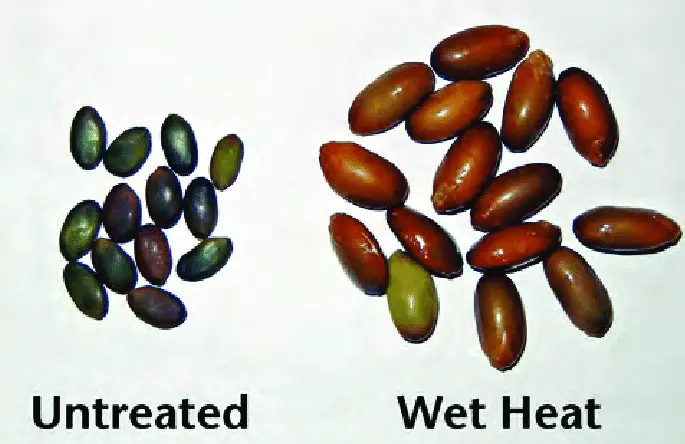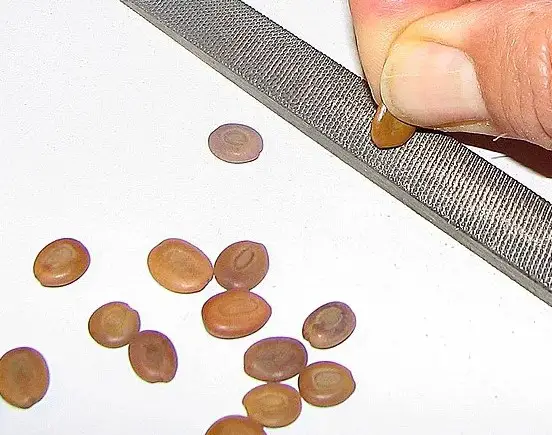Seed germination is a critical process in the lifecycle of plants, influenced greatly by how seeds are treated before planting. Stratification and scarification are two specialized techniques that enhance germination by mimicking natural environmental conditions or by physically altering the seed coat. While they may sound similar, their methods and purposes differ significantly.
Stratification involves simulating natural winter conditions to break the dormancy of seeds, thereby promoting germination. This process requires seeds to be exposed to cold, moist conditions for varying periods depending on the species. Scarification, on the other hand, refers to breaking, scratching, or softening the seed coat to allow water and gases to penetrate, which initiates the germination process.
Both techniques are essential in horticulture and agriculture for ensuring robust seed germination. Stratification is typically used for seeds that are naturally adapted to cold climates, whereas scarification is applied to seeds with thick, impermeable seed coats. Understanding when and how to use each method can significantly impact the success rate of growing plants from seeds.

What is Stratification?
Definition of Stratification
Stratification in horticulture refers to the process of treating seeds to simulate natural environmental conditions that the seeds must endure before germination. This process typically involves exposing seeds to cool and moist conditions that mimic winter.
Purpose of Stratification in Seed Germination
The primary purpose of stratification is to break the dormancy of seeds, making them ready to sprout when planting conditions are favorable. Dormancy is a seed’s natural way of preventing germination during unsuitable environmental conditions.
Stratification Process
Cold Stratification Explained
Cold stratification is designed to overcome the dormancy barriers of seeds that require exposure to cold weather before they will germinate. This method involves chilling seeds within a moist medium such as sand, soil, or paper towels, typically within a refrigerator.
Steps Involved in Stratification
- Moisten the medium: Use sand, peat moss, or paper towels and moisten it slightly.
- Place the seeds: Mix the seeds into the medium, ensuring they are evenly distributed.
- Seal in a container: Place the moist medium and seeds into a plastic bag or container.
- Store the container: Keep the container in a refrigerator set to 2-5°C (35-41°F) for the duration required by the seed type.
- Check periodically: Monitor moisture levels and check for mold or fungus growth, addressing any issues as they arise.
- Remove and plant: After the stratification period, remove the seeds and plant them under suitable growth conditions.
Types of Seeds That Require Stratification
Many tree and shrub species from temperate climates require cold stratification. Examples include maples, dogwoods, and magnolias, which need this treatment to simulate winter conditions that tell the seeds it is safe to germinate.
Benefits of Stratification
Impact on Seed Germination
Stratification significantly improves germination rates by breaking down the chemical inhibitors within the seed coat. This process ensures that the seeds will only germinate when environmental conditions are optimal, thus increasing the likelihood of survival.
Examples of Successful Stratification
- Apple seeds: Stratifying apple seeds in cold conditions leads to higher germination rates compared to non-stratified seeds.
- Magnolia trees: By mimicking winter conditions, stratification helps magnolia seeds to sprout more uniformly and successfully.
What is Scarification?
Definition of Scarification
Scarification involves physically or chemically altering the seed coat to make it more permeable to water and gases. This treatment is crucial for seeds with thick, hard coats that naturally resist water penetration.
Purpose of Scarification in Seed Treatment
The goal of scarification is to speed up germination by ensuring that water and air can reach the embryo inside the seed. This is particularly important for seeds that do not respond well to stratification and have impermeable seed coats.
Scarification Techniques
Physical Scarification Methods
Physical scarification refers to methods where the seed coat is manually damaged to allow water and air to penetrate. Common techniques include:
- Sanding or filing: Using sandpaper or a file to wear down the seed coat.
- Nick with a knife: Making a small cut in the seed coat using a sharp knife.
- Cracking with pliers: Gently squeezing seeds with hard shells in pliers to create a crack.
Chemical Scarification Methods
Chemical scarification uses chemicals to break down the seed coat. It includes:
- Acid treatment: Soaking seeds in a diluted acid solution, typically sulfuric acid, to etch away the hard outer layer.
- Potassium nitrate: Soaking seeds in a potassium nitrate solution to soften the seed coat.
Thermal Scarification Methods
Thermal scarification involves using heat to breach the seed coat:
- Hot water treatment: Pouring boiling water over the seeds and letting them soak as the water cools.
- Direct fire exposure: Briefly exposing seeds to flames to crack their coats.
Benefits of Scarification
Enhancement of Germination Rates
Scarification can dramatically improve germination rates by breaking through the seed coat that otherwise blocks moisture and gas exchange essential for sprouting.
Seeds That Benefit from Scarification
- Legumes: Such as beans and peas, which have thick coats.
- Lupins: Known for their hard shells, responding well to scarification.
Key Differences
Comparison of Techniques
While stratification mimics cold weather conditions to end dormancy, scarification physically alters the seed coat to promote water and air absorption.
Situational Usage for Each Method
Stratification is used primarily for seeds native to cold climates, whereas scarification is ideal for seeds with tough, impermeable coats regardless of their native environment.
Impact on Different Types of Seeds
Stratification is crucial for temperate climate seeds like cherries and walnuts. In contrast, tropical seeds such as morning glory and moonflowers benefit more from scarification.
Case Studies
Real-World Examples of Stratification
- Cherry trees: Stratification helps to simulate the cold winters that cherry seeds need before they will germinate.
- Hawthorn berries: Cold stratification mimics their natural wintering, which helps to break seed dormancy effectively.
Real-World Examples of Scarification
- Sweet peas: Physical scarification increases their germination success.
- Honey locust: Soaking in hot water serves to weaken the hard outer shell, promoting germination.
Analysis of Outcomes
In both techniques, treated seeds show higher and more rapid germination rates compared to untreated seeds, proving the effectiveness of each method in suitable contexts.
Best Practices
Tips for Effective Stratification
- Ensure consistent moisture: Keep the medium moist throughout the stratification period.
- Maintain proper temperature: Use a refrigerator for cold stratification to provide a stable environment.
- Time your process: Different seeds require different durations; timing is crucial.
Tips for Effective Scarification
- Choose the right method: Match the scarification technique to the type of seed coat.
- Be gentle: Avoid damaging the embryo when applying physical methods.
- Test a few seeds first: Experiment with a small number of seeds to find the optimal method before treating all your seeds.
Common Mistakes to Avoid
- Over-soaking in chemical solutions: This can damage the seed.
- Applying excessive heat: This can kill the seed instead of promoting germination.
- Ignoring species-specific needs: Each seed type may require a different stratification or scarification method.
FAQs
What is seed stratification?
Seed stratification is a pretreatment method that mimics winter-like conditions to break the dormancy of seeds. This typically involves chilling seeds in a moist substrate for a period that can range from weeks to months, depending on the species, to trigger natural germination processes once planted.
How does scarification enhance germination?
Scarification enhances germination by physically or chemically altering the seed coat. This alteration helps in breaking down the barriers that prevent water absorption, a critical trigger for the germination process. Effective scarification speeds up germination and increases the overall germination rate.
Which seeds require stratification?
Seeds of many temperate plants, including certain trees, shrubs, and perennials, require stratification to germinate effectively. These seeds possess natural inhibitors that prevent them from sprouting until they’ve experienced winter-like conditions.
Can you scarify seeds at home?
Yes, gardeners can perform scarification at home using simple tools like sandpaper, a file, or a knife to gently wear down the seed coat. For seeds requiring chemical scarification, soaking them in mild acidic solutions can also be effective.
Is stratification safe for all seeds?
Stratification is not necessary or beneficial for all seed types. It is specifically tailored to seeds that undergo a period of dormancy and require cold exposure. Applying stratification to tropical seeds, for example, might actually inhibit their ability to germinate.
Conclusion
Stratification and scarification are both critical yet distinct seed treatment techniques that cater to different types of seeds and germination requirements. By employing these methods, gardeners and agriculturalists can significantly enhance the likelihood of successful plant growth. Understanding the specific needs of your seeds and applying the correct treatment method can make a substantial difference in your gardening and farming endeavors.
In conclusion, whether you’re a seasoned gardener or starting your first planting project, recognizing and implementing these methods can lead to a deeper appreciation of plant biology and more successful gardening outcomes. Such knowledge not only optimizes your efforts but also enriches your interaction with the natural world.

